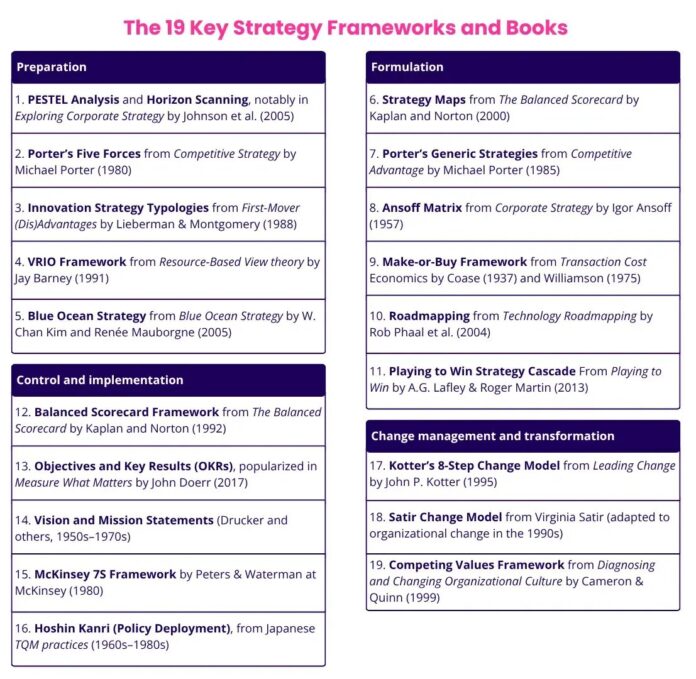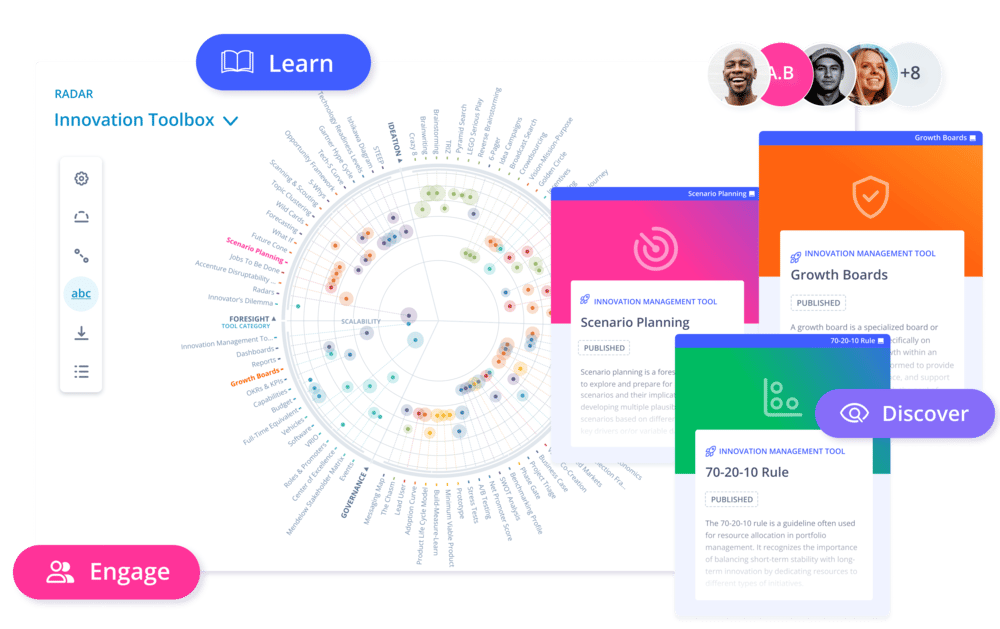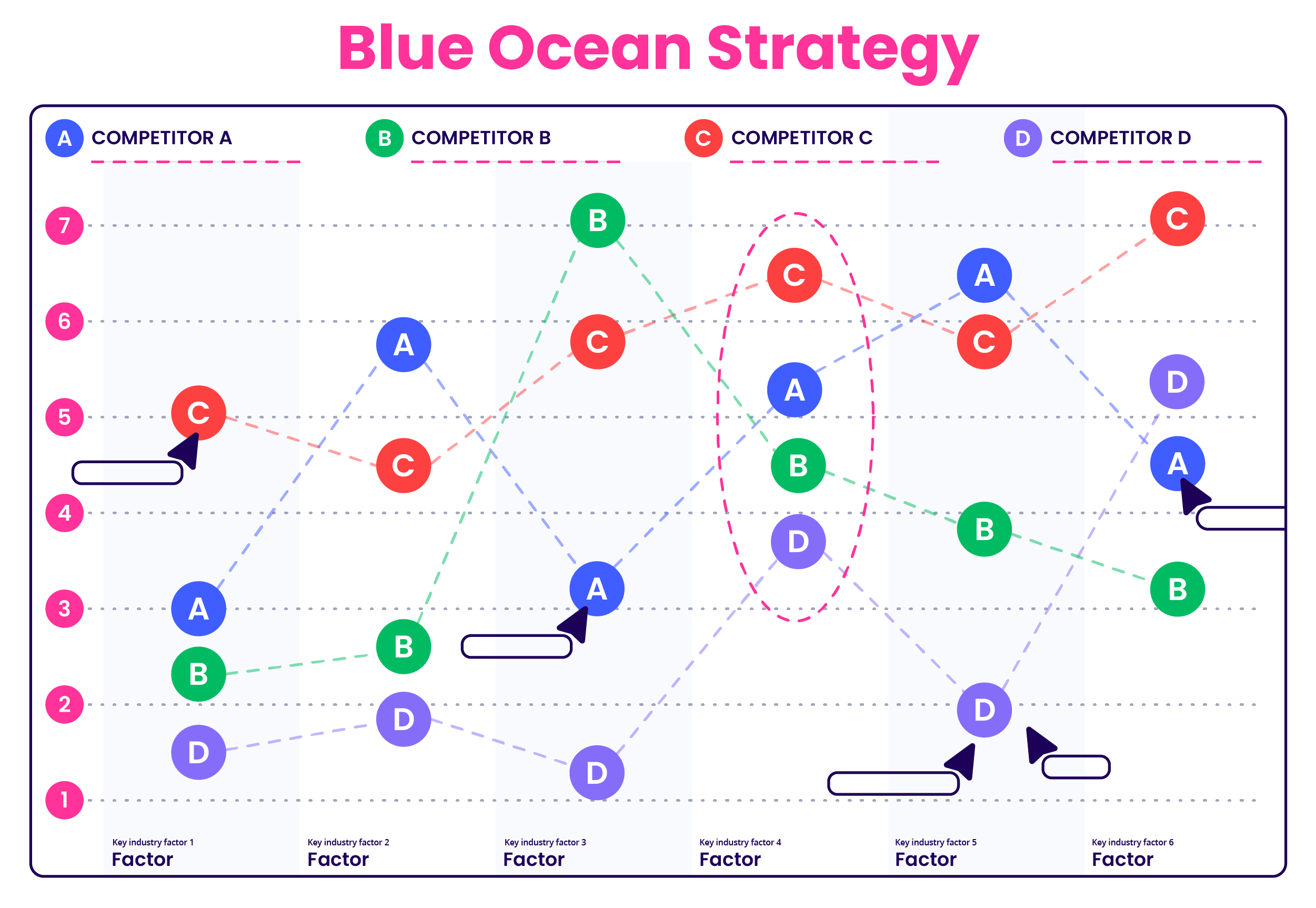Tired of strategy sessions that start with brainstorming ideas and end in confusion?
It’s time to bring structure to the chaos. The best companies don’t rely on brainstorming sessions. They utilize strategic planning models that transform ambitious goals into informed decisions, decisive actions, and tangible outcomes.
In this guide, we’ve handpicked 19 of the most widely used strategy frameworks from the world’s best business books. Whether you’re mapping your next market, fixing internal messes, or leading change, these tools will help you cut through noise, focus on what matters, and get strategic plans done.
How do strategy frameworks influence business success
Strategy frameworks play a crucial role in shaping future success by turning vision into action. Well-chosen strategic planning models help identify strengths, reveal gaps, and define the right path forward, what some call the “departure hall connects” moment between current state and future ambition.
Whether through gap planning, OKRs, or the Balanced Scorecard, frameworks help translate strategic plans into measurable key results. An alignment strategic planning model ensures that high-level objectives are cascaded across teams and tracked over time.
Ultimately, these frameworks drive focus, agility, and clarity that are core enablers of sustained business performance in fast-changing markets.
Summaries and FAQs on strategy frameworks
The 19 most influential strategy models from the best books on strategy
Preparation and gap planning
Effective preparation begins with understanding both the external landscape and internal readiness.
Tools like Pest Analysis and Internal Capability Gap Planning are among the most popular strategic planning frameworks, helping organizations identify future risks, opportunities, and the distance between current capabilities and strategic needs.
1. PESTEL Analysis and Horizon Scanning, notably in Exploring Corporate Strategy by Johnson, Scholes & Whittington (2005)
PESTEL analysis is a foundational tool in the strategic planning process that helps organizations scan and monitor external factors likely to influence performance.
It categorizes these into six domains: Political, Economic, Social, Technological, Environmental, and Legal. When paired with horizon scanning, organizations systematically detect emerging trends and weak signals, which can be visualized using a strategic planning model such as a trend radar.

The core contribution of PEST analysis lies in its ability to structure foresight activities and align strategic decisions with the broader business environment.
2. Porter’s Five Forces from Competitive Strategy by Michael Porter (1980)
Porter’s Five Forces is a cornerstone of competitive analysis, helping organizations assess the attractiveness of an industry by examining five forces: threat of new entrants, bargaining power of suppliers, bargaining power of buyers, threat of substitutes, and competitive rivalry. By identifying these pressures, businesses can position themselves more effectively in their chosen market space.
Its core contribution is turning competitive advantage into a systematic assessment. It remains widely used in strategic frameworks for everything from new market entry to organic model development and helps align internal priorities to external threats. Often integrated with SWOT analysis, it also informs framework outlines for broader business strategy.
3. Innovation Strategy Typologies from First-Mover (Dis)Advantages by Lieberman & Montgomery (1988)
This framework categorizes innovation strategies by timing of entry and market behavior: first-movers aim to establish early dominance, fast followers improve on pioneers’ offerings, and disruptors challenge industry norms. These typologies are key in shaping a company’s strategic direction, especially in tech, biotech, and digital markets.

Its core contribution is enabling firms to align strategies with market readiness and innovation capabilities. By choosing the right entry timing, companies can avoid costly mistakes or capitalize on competitors’ weaknesses. This model directly supports market penetration decisions and new product development paths within a strategic planning framework.
4. VRIO Framework from Resource-Based View theory by Jay Barney (1991)
The VRIO framework evaluates whether internal resources and capabilities provide sustainable competitive advantage based on four tests: Value, Rarity, Imitability, and Organization. It builds on the resource-based view of the firm, shifting attention from external threats to internal strengths.
Its core contribution is linking internal factors to long-term priorities. VRIO is often used during strategic goal-setting, innovation audits, and M&A due diligence. By identifying which assets are truly unique and aligned with strategic objectives, firms can allocate resources wisely and develop what Porter calls core competencies.
5. Blue Ocean Strategy from Blue Ocean Strategy by W. Chan Kim and Renée Mauborgne (2005)
Blue Ocean Strategy offers a radical approach to value creation: rather than competing in crowded “red oceans,” companies seek uncontested market space through value innovation. This means simultaneously reducing cost and increasing customer value—opening up new demand.
Its core contribution is strategic differentiation beyond price wars. Tools like the strategy canvas and the Four Actions Framework help redefine industries and challenge assumptions about competitive dynamics.
Formulation
Strategy formulation is where insights turn into choices, deciding how to compete, grow, and differentiate.
Using strategic planning models like SWOT analysis and the Ansoff Matrix, businesses connect internal strengths and available raw materials to external opportunities, revealing the cause and effect connections that shape successful go-to-market.
6. Strategy Maps from The Balanced Scorecard by Kaplan and Norton (2000)
Strategy Maps are a central component of the Balanced Scorecard framework, introduced to show how strategic objectives are connected across four perspectives: financial performance, customer value, internal processes, and learning & growth. These maps serve as visual representations of strategy, clarifying the causal relationships that drive business outcomes.
Their core contribution is making intangible plans actionable. Strategy Maps help organizations articulate a strategic planning model that aligns people and performance metrics with strategic goals. They’re especially powerful in large organizations seeking alignment between strategic objectives and day-to-day operations.

7. Porter’s Generic Strategies from Competitive Advantage by Michael Porter (1985)
In his seminal work Competitive Advantage, Porter outlined three basic archetypes to achieve sustainable competitive advantage: cost leadership, differentiation, and focus. These strategic frameworks help organizations select a clear value proposition based on either broad market appeal or niche targeting.
The core contribution is the warning against being “stuck in the middle”, trying to pursue all three and failing at each. By committing to one, organizations sharpen their go-to-market direction and avoid diluting their efforts. This model underpins most modern business strategy discussions, especially in industries with high competitive rivalry and complex value chains.
8. Ansoff Matrix from Corporate Strategy by Igor Ansoff (1957)
The Ansoff Matrix helps organizations explore four growth archetypes: market penetration, product development, market development, and diversification. Each archetype varies in its degree of risk and alignment with existing products and markets.
%20Innovation%20ambition%20matrix.webp?width=850&height=917&name=6)%20Innovation%20ambition%20matrix.webp)
Its core contribution is helping leaders assess the strategic planning process through a growth lens. It enables more informed choices by structuring the discussion around existing products, new strategy, and market space expansion. This model is frequently used during planning processes and strategic workshops to explore scalable growth.
9. Make-or-Buy Framework from Transaction Cost Economics by Coase (1937) and Williamson (1975)
This strategic planning model addresses a classic dilemma in strategic planning: should a firm develop capabilities in-house, buy them via acquisition, or partner externally? The Make-or-Buy decision balances control, speed, cost, and long-term strategic fit, especially relevant when sourcing talent, tech, or manufacturing capacity.
Its core contribution is guiding resource allocation for innovation and capability building. The model is widely used in R&D, outsourcing decisions, and post-M&A planning. It supports alignment models by ensuring that sourcing decisions complement the organization’s strategic planning framework and not just short-term cost savings.

10. Strategic Roadmapping by Rob Phaal (2004)
Strategic Roadmapping is a visual planning model that aligns market needs, product development, and enabling technologies along a timeline.
Its core contribution is creating a shared future-focused narrative that links strategic goals to real-world activities. Roadmaps support prioritization, capability building, and long-term investments while addressing the strategic planning gap. They’re especially useful in dynamic environments where real-time data and external factors shift rapidly.
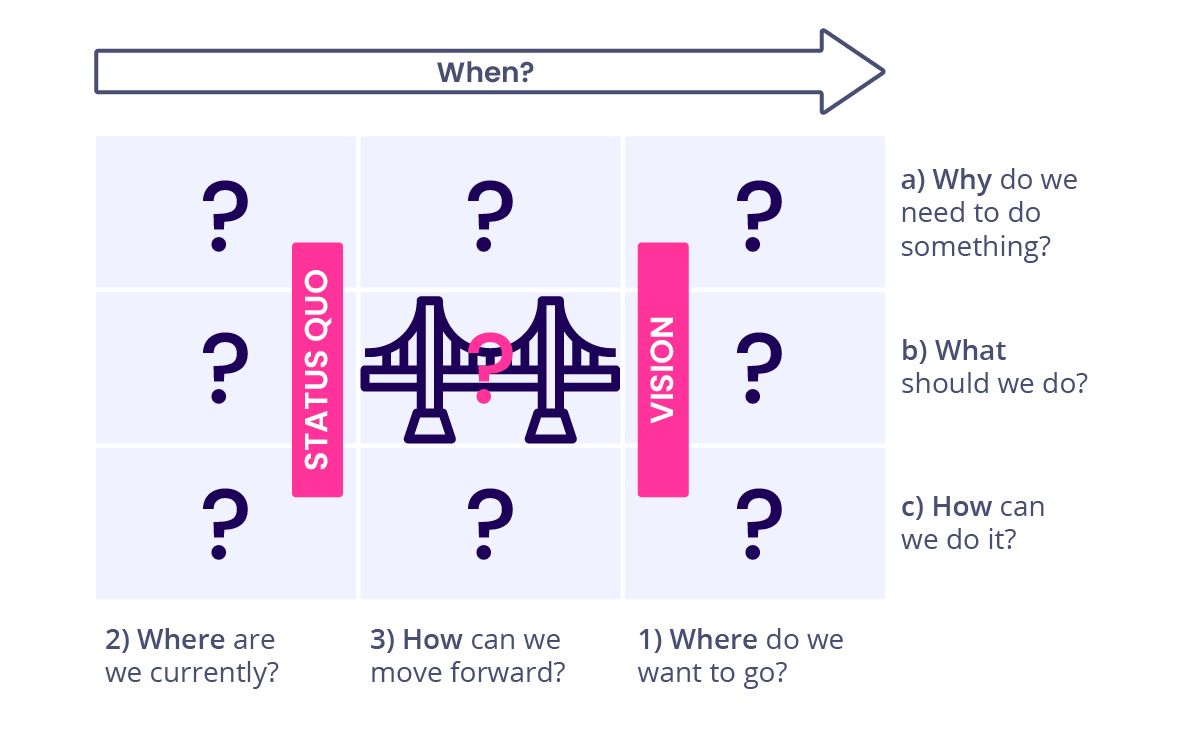
11. Playing to Win Strategy Cascade From Playing to Win by A.G. Lafley & Roger Martin (2013)
The Playing to Win cascade is a practical, decision-driven strategic planning framework. It poses five essential questions every business must answer in every strategic planning process:
-
What is our winning aspiration?
-
Where will we play?
-
How will we win?
-
What capabilities must be in place?
-
What management systems are required?
The model moves beyond vague vision statements and pushes teams to define actionable choices. Its core contribution is helping organizations build a coherent alignment model between strategic objectives, day-to-day operations, and long-term success. Each question prompts clear, focused decisions that together create a holistic strategic planning framework.
Control and implementation
Control and implementation ensure that strategic intent translates into measurable outcomes and day-to-day actions.
Strategic frameworks like the Balanced Scorecard or issue-based strategic planning help organizations prioritize challenges, assign ownership, and continuously track progress toward long-term objectives.
12. Balanced Scorecard Framework from The Balanced Scorecard by Kaplan and Norton (1992)
The Balanced Scorecard (BSC) is one of the most widely used strategic planning models, helping organizations measure performance beyond traditional financial indicators. Kaplan and Norton introduced four perspectives (financial, customer, internal processes, and learning & growth) to ensure that key success drivers are included in strategy execution tracking.
The Balanced Scorecard transforms performance measurement into a tool for strategic execution. By linking objectives to key results and KPIs across departments, it fosters internal alignment and long-term value creation. It is particularly powerful in bigger organizations where internal factors and siloed thinking can obstruct strategic clarity.
13. Objectives and Key Results (OKRs) from Intel (1970s), popularized in Measure What Matters by John Doerr (2017); MbO from The Practice of Management by Peter Drucker (1954)
OKRs (Objectives and Key Results) are a modern strategic planning framework that helps organizations set bold goals and measure progress through specific, time-bound outcomes. Used by Google and many startups, OKRs bring agility and transparency to the strategic planning process, fostering ownership across all levels of the organization.
MbO, developed by Drucker, is a precursor to OKRs. It emphasizes mutual goal setting between managers and employees, combined with regular performance reviews. While less dynamic than OKRs, MbO is still valued in hierarchical organizations for its clarity and goal accountability.
The core contribution of both methods is structured goal-setting. OKRs excel in fast-moving, innovation-driven settings, while MbO remains relevant for operational planning and leadership team management.
14. Vision and Mission Statements (Drucker and others, 1950s–1970s)
Vision and mission statements define the fundamental purpose of an organization (mission) and its long-term aspirations (vision). These tools are essential for expressing the “why” behind the strategic plans, giving direction to decision-making, and inspiring employee engagement.

Missions articulate what the organization does, for whom, and how. Vision statements describe where it aims to go. Together, they form the foundation for goal-setting, cultural alignment, and strategic prioritization. They are often the first step in any strategic planning model and provide context for every initiative that follows.
Their core contribution is anchoring the organization’s vision in meaning and intention, which is vital for both internal alignment and external communication.
15. McKinsey 7S Framework by Peters & Waterman at McKinsey (1980)
The McKinsey 7S Framework ensures strategic alignment across seven interrelated elements: Strategy, Structure, Systems, Shared Values, Style, Staff, and Skills. Developed during the early 1980s, it addresses both the hard elements (strategy, systems, structure) and soft elements (culture, leadership style, talent).
The core insight is that execution depends on how well it fits with the organization’s culture and capabilities. It also supports diagnostics during transformation and provides a checklist for ensuring strategic change doesn’t falter due to hidden cultural or structural mismatches.
16. Hoshin Kanri (Policy Deployment), from Japanese TQM practices (1960s–1980s)
Hoshin Kanri is a strategic planning model and execution framework that translates high-level vision into specific, measurable actions at every level of the organization. Through a method of cascading objectives, it ensures that strategic goals are supported by tactical plans, with built-in cycles for review and adaptation.
It is especially effective in environments where real-time data, internal processes, and team accountability need to be tightly integrated, such as manufacturing, healthcare, and agile transformation efforts.
The core contribution is that it institutionalizes alignment, like RACI, and follow-through. Everyone in the entire organization (from leadership to front-line staff) can trace their work directly to the strategic plan.

Change management and transformation
Change management and transformation focus on aligning people, culture, and systems with evolving goals.
Strategic frameworks like Kotter’s 8 Steps and the Competing Values Framework guide organizations through transitions, ensuring that strategic plan execution is supported by emotional buy-in, cultural readiness, and long-term behavioral change.
17. Kotter’s 8-Step Change Model from Leading Change by John P. Kotter (1995)
Kotter’s 8-Step Model is one of the most popular and enduring strategic planning models for leading organizational transformation. It outlines a clear, phased approach:
-
Create urgency
-
Build a guiding coalition
-
Form a strategic vision
-
Enlist a volunteer army
-
Enable action by removing barriers
-
Generate short-term wins
-
Sustain acceleration
-
Institute change
This framework emphasizes that strategy execution needs deep emotional buy-in, strong leadership, and cultural reinforcement.
Its core contribution is showing that effective change is not just technical, but human. By guiding leaders through each phase, this strategic planning framework ensures that change becomes part of the organization’s development and everyday behaviors.
18. Satir Change Model from Virginia Satir (adapted to organizational change in the 1990s)
Originally developed by family therapist Virginia Satir, this strategic planning model was later adapted for organizational transformation to illustrate the emotional journey individuals and teams go through during major change. It maps five key stages: Late Status Quo, Resistance, Chaos, Integration, and New Status Quo.
The core contribution is its focus on the human, emotional side of transformation. By recognizing that performance and morale often dip before rising again, it helps leaders guide teams with empathy and patience, especially during disruptive change, agile transitions, or restructuring.
19. Competing Values Framework from Diagnosing and Changing Organizational Culture by Cameron & Quinn (1999)
The Competing Values Framework (CVF) categorizes organizational cultures along two axes: internal vs. external focus and stability vs. flexibility. This results in four dominant culture types: Clan (collaborative), Adhocracy (creative), Market (competitive), and Hierarchy (controlled). Each supports different values, leadership styles, and strategic priorities.

The core contribution is its use as both a diagnostic and developmental tool, helping organizations align culture with strategy. Whether pursuing innovation, operational excellence, or customer-centricity, CVF helps leaders understand the cultural shifts required to support their goals.
How to effectively use the different strategy methods
Strategic planning is not a once-a-year exercise. It’s a continuous strategic process of aligning internal capabilities with external factors to drive business success. But with dozens of popular strategic planning models available, how do you choose the right one, or better yet, use several in harmony?
Start with a clear strategic planning framework. Models like PESTEL or Porter’s Five Forces help assess external factors like government regulations, competitive rivalry, or new small business moves. The pest analysis helps to understand shifts in the environment.
Software like ITONICS – The Innovation Software helps track these shifts and highlights the key elements. Interactive radars help map the environment and identify the priorities to adjust strategic plans continuously.

To maintain strategic alignment, tools like roadmaps, balanced scorecards, or strategy maps transform abstract goals into measurable key results. This is where software excels: it allows cascading objectives across departments and connecting KPIs to your organization’s mission.
Software like ITONICS allows you to translate strategic plans into aligned roadmaps, assign ownership, monitor progress, and ensure high-level objectives aren’t lost in daily operations. It also makes it easier to review and update your strategic plan regularly, especially in response to major issues or market shifts.
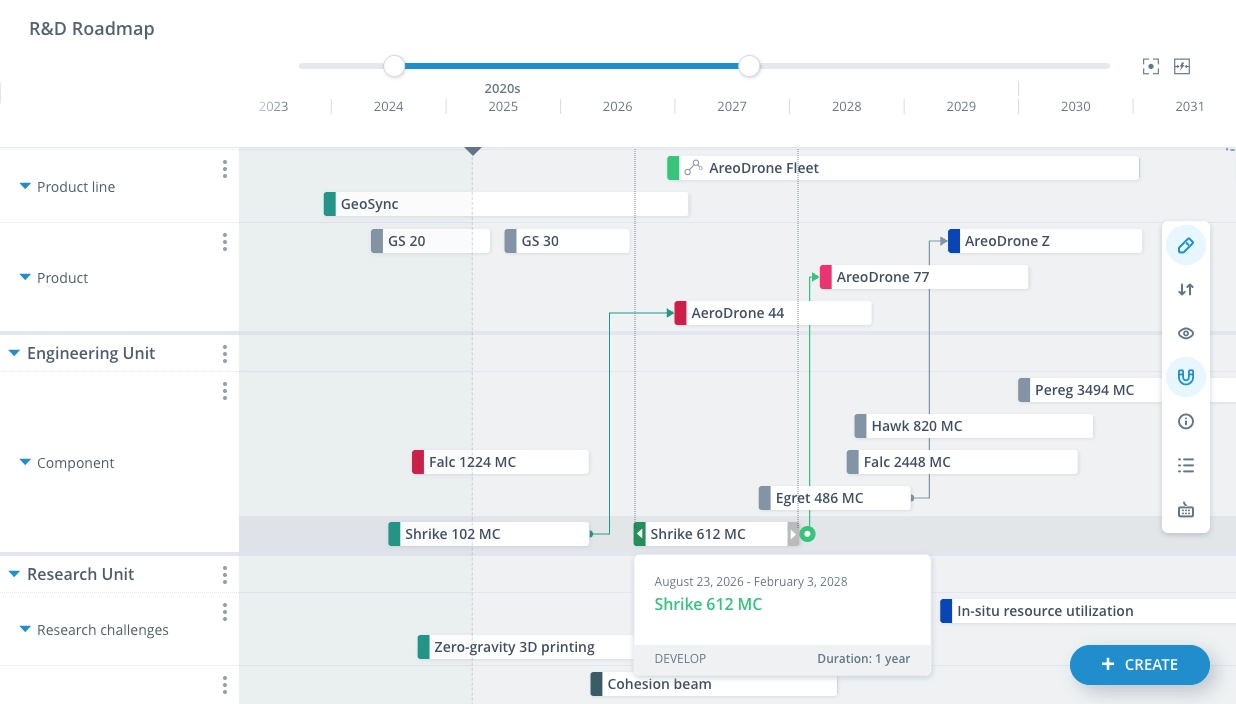
Finally, using an integrated platform prevents your strategic planning process from becoming siloed. The result? An alignment that evolves with your business, powered by data, structured frameworks, and shared insight, bringing clarity to how to achieve goals across the entire organization.
The ITONICS Innovation OS is the modular and best strategy software to give teams the tools they need and foster innovation synergies across the whole organization.
/Still%20images/Portfolio-product-header-1000px.webp?width=1000&height=629&name=Portfolio-product-header-1000px.webp)
It will help you to:
Eliminate information silos: Dispersed teams and disconnected data often result in missed opportunities and duplicated efforts. With ITONICS, all your new products, most innovative ideas, and market insights are centralized in one place. Create transparency and reduce inefficiencies by keeping everyone on the same page.
Turn strategic plans into accountability and actions: Translate your company goals into clear tasks and timelines. Build interactive roadmaps that break down long-term objectives into specific initiatives, allocate resources effectively, and ensure every team knows its role in driving the strategic plan forward.
Track innovation progress across teams: Monitoring the progress of multiple innovation projects across departments isn’t easy. ITONICS provides visual dashboards and roadmapping that give you a real-time overview of ongoing projects, ensuring you can quickly address roadblocks, identify risks, and keep everything on track.
